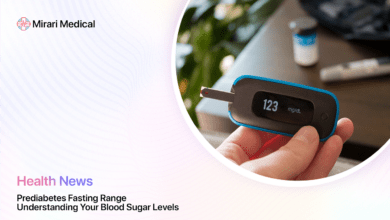A1c of 6.1: Understanding Prediabetes

You may be interested
Did you know that over 96 million American adults have prediabetes, and more than 80% of them are unaware of their condition? An A1c level between 5.7% and 6.4% is a strong indicator of prediabetes, a serious health concern that, if left unmanaged, can lead to the development of type 2 diabetes and other life-threatening complications. If your recent A1c test revealed a result of 6.1%, it’s crucial to understand the implications and take proactive steps to protect your health.
What is an A1c Test?
Before diving into the significance of an A1c of 6.1, let’s first understand what the A1c test is and how it works.
Understanding A1c Levels
The A1c test, also known as the hemoglobin A1c or HbA1c test, is a simple blood test that provides a snapshot of your average blood sugar levels over the past two to three months. The test measures the percentage of your red blood cells that have glucose attached to them, which is an indicator of how well your body has been managing blood sugar over an extended period.
A1c of 6.1: The Prediabetes Range
An A1c level between 5.7% and 6.4% is considered prediabetes. A result of 6.1% falls within this range, indicating that your blood sugar levels have been consistently higher than normal. While not yet in the diabetic range (6.5% or above), this elevated A1c level serves as a warning sign that you are at an increased risk of developing type 2 diabetes if you don’t take action to lower your blood sugar.
What Does an A1c of 6.1 Mean?
An A1c of 6.1 is a clear indication of prediabetes, a condition characterized by higher-than-normal blood sugar levels that are not yet high enough to be classified as type 2 diabetes. Understanding the risks associated with prediabetes is crucial for taking control of your health and preventing serious complications.
Prediabetes: A Risk Factor for Type 2 Diabetes
One of the most significant risks of prediabetes is the increased likelihood of developing type 2 diabetes. Studies have shown that without lifestyle changes, most people with prediabetes will progress to type 2 diabetes within 10 years. However, the good news is that with early intervention and proper management, it is possible to delay or even prevent the onset of type 2 diabetes.
Potential Complications of Prediabetes
In addition to the risk of developing type 2 diabetes, prediabetes can also lead to other serious health complications, such as:
- Cardiovascular disease: Prediabetes increases the risk of heart disease and stroke, as high blood sugar levels can damage blood vessels and nerves over time.
- Kidney damage: Elevated blood sugar levels can harm the kidneys, leading to chronic kidney disease or even kidney failure.
- Nerve damage: Prediabetes can cause damage to the nerves, particularly in the feet and legs, leading to numbness, tingling, and pain.
- Eye problems: High blood sugar levels can damage the tiny blood vessels in the eyes, potentially causing vision loss or blindness.
What to Do If Your A1c is 6.1
If your A1c level is 6.1%, it’s crucial to take proactive steps to manage your prediabetes and lower your risk of developing type 2 diabetes. The primary focus should be on lifestyle changes that can help lower your blood sugar levels and improve your overall health.
Lifestyle Changes to Lower Your A1c
Diet Modifications
Making healthy food choices is a critical component of managing prediabetes. Focus on a balanced diet that includes:
- Complex carbohydrates: Choose whole grains, fruits, and vegetables, which are rich in fiber and nutrients.
- Lean proteins: Incorporate lean proteins, such as fish, poultry, and plant-based sources like legumes and tofu, into your meals.
- Healthy fats: Include healthy fats from sources like avocados, nuts, seeds, and olive oil, which can help improve heart health and manage blood sugar levels.
- Limit simple carbohydrates: Reduce your intake of simple carbohydrates, such as sugary drinks, candy, and refined grains, which can cause rapid spikes in blood sugar levels.
- Practice portion control: Be mindful of your overall carbohydrate intake and practice portion control to maintain a healthy weight.
Exercise Recommendations
Regular physical activity is one of the most effective ways to manage prediabetes and lower your A1c levels. Exercise helps your body use insulin more efficiently, which can help lower blood sugar levels. Aim for at least 150 minutes of moderate-intensity aerobic activity per week, such as brisk walking, swimming, or cycling. Additionally, incorporate strength training exercises at least twice a week to build muscle and further improve insulin sensitivity.
Weight Management
If you are overweight or obese, losing weight can significantly improve your A1c levels and reduce your risk of developing type 2 diabetes. Even a modest weight loss of 5-7% of your body weight can make a substantial difference in your blood sugar control. Work with your healthcare provider or a registered dietitian to develop a safe and sustainable weight loss plan that fits your lifestyle and preferences.
Stress Reduction
Chronic stress can lead to elevated blood sugar levels, making it more challenging to manage prediabetes. Incorporate stress-reducing activities into your daily routine, such as:
- Practicing relaxation techniques like deep breathing, meditation, or yoga
- Engaging in hobbies or activities that bring you joy and help you unwind
- Seeking support from friends, family, or a mental health professional when needed
Medications for Prediabetes
In some cases, lifestyle changes alone may not be sufficient to manage prediabetes effectively. Your healthcare provider may recommend medications to help lower your blood sugar levels and reduce your risk of developing type 2 diabetes.
Metformin: A Common First-Line Drug
Metformin is the most commonly prescribed medication for prediabetes. It works by reducing the amount of glucose produced by the liver and improving the body’s sensitivity to insulin. Metformin has been shown to be particularly effective in reducing the risk of progression from prediabetes to type 2 diabetes, especially when combined with lifestyle changes.
Other Medications for Prediabetes
While metformin is the first-line treatment for prediabetes, your healthcare provider may consider other medications based on your individual needs and medical history. These may include:
- Alpha-glucosidase inhibitors: These medications slow the absorption of carbohydrates in the intestines, helping to prevent blood sugar spikes after meals.
- Thiazolidinediones: These drugs improve insulin sensitivity in the body’s cells, allowing for better blood sugar control.
- GLP-1 receptor agonists: These injectable medications help regulate blood sugar levels by increasing insulin production and slowing glucose absorption in the gut.
It’s essential to work closely with your healthcare provider to determine the most appropriate medication regimen for your specific situation.
Importance of Regular Monitoring
In addition to lifestyle changes and medications, monitoring your blood sugar levels is an essential part of managing prediabetes and preventing the progression to type 2 diabetes. Your healthcare provider may recommend regular A1c tests to track your progress and make necessary adjustments to your management plan.
A1c Conversion Rates
Understanding how your A1c level relates to your average blood sugar levels can help you better manage your prediabetes.
A1c to Blood Sugar Conversion
The following table provides a general guide for converting A1c percentages to average blood sugar levels:
| A1c (%) | Average Blood Sugar (mg/dL) |
|---|---|
| 5.7 | 117 |
| 6.0 | 126 |
| 6.1 | 129 |
| 6.2 | 132 |
| 6.3 | 136 |
| 6.4 | 139 |
Keep in mind that these are average values, and individual blood sugar levels may vary throughout the day.
Living with Prediabetes
Managing prediabetes is a lifelong commitment to maintaining healthy habits and monitoring your blood sugar levels.
Managing Prediabetes for Long-Term Health
To effectively manage prediabetes and reduce your risk of developing type 2 diabetes, it’s essential to:
- Maintain a balanced, nutrient-rich diet
- Engage in regular physical activity
- Achieve and maintain a healthy weight
- Manage stress through relaxation techniques and self-care
- Attend regular checkups with your healthcare provider
- Monitor your blood sugar levels as recommended
Preventing Progression to Type 2 Diabetes
By making healthy lifestyle choices and working closely with your healthcare team, you can significantly reduce your risk of progressing from prediabetes to type 2 diabetes. Studies have shown that with intensive lifestyle modifications, such as regular exercise, a healthy diet, and weight loss, it is possible to reverse prediabetes and return blood sugar levels to the normal range.
Resources for Prediabetes Management
Managing prediabetes can be challenging, but you don’t have to do it alone. There are numerous resources and support systems available to help you navigate this journey and achieve your health goals.
Healthcare Provider Consultations
Working with a knowledgeable and supportive healthcare provider is crucial for successfully managing prediabetes. Look for a primary care physician, endocrinologist, or diabetes specialist who has experience in treating prediabetes and can provide personalized guidance and support.
Online Resources and Support Groups
There are many online resources and support groups available for people living with prediabetes. Some reputable sources include:
- American Diabetes Association (ADA)
- National Institute of Diabetes and Digestive and Kidney Diseases (NIDDK)
- Centers for Disease Control and Prevention (CDC)
- Diabetes Daily’s forums
- Facebook groups dedicated to prediabetes and diabetes management
These resources can provide valuable information, support, and practical advice for managing prediabetes and connecting with others who understand the challenges of living with this condition.
Diabetes Organizations and Support Networks
Joining a diabetes organization or support network can provide access to educational materials, support groups, and community events. Some well-known organizations include:
- American Diabetes Association (ADA)
- Juvenile Diabetes Research Foundation (JDRF)
- Diabetes Research Institute Foundation (DRIF)
- Diabetes Hands Foundation (DHF)
These organizations offer a wealth of resources and support for people living with prediabetes and diabetes, as well as their families and caregivers.
Key Takeaways
- An A1c level of 6.1% indicates prediabetes, a condition characterized by higher-than-normal blood sugar levels that are not yet high enough to be classified as type 2 diabetes.
- Prediabetes increases the risk of developing type 2 diabetes, heart disease, kidney damage, nerve damage, and eye problems.
- Lifestyle changes, such as a balanced diet, regular exercise, weight loss, and stress management, are crucial for managing prediabetes and lowering A1c levels.
- In some cases, medications like metformin may be prescribed to help manage prediabetes and reduce the risk of progression to type 2 diabetes.
- Regular monitoring of blood sugar levels and A1c tests are essential for tracking progress and making necessary adjustments to your management plan.
- Numerous resources and support systems, including healthcare providers, online communities, and diabetes organizations, are available to help individuals navigate life with prediabetes.
By understanding the significance of an A1c of 6.1 and taking proactive steps to manage your prediabetes, you can protect your health and reduce your risk of developing serious complications. Remember, you have the power to make positive changes and take control of your well-being. Work closely with your healthcare team, lean on your support network, and prioritize your health and quality of life.
Your trusted source for health info, offering expert advice, news, and tips to stay healthy and informed.





